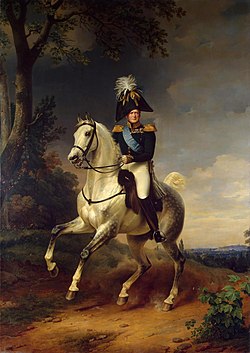Eduard Olsov
His Excellency Eduard Olsov | |
|---|---|
 Portrait of Olsov drawn in 1866 | |
| 1st President of Narozalica | |
| In office 13 July 1861 – 8 September 1904 | |
| Preceded by | Position created Ivan VI (as Emperor) |
| Succeeded by | Pyotr Petrovich |
| Lord Commander of the Narozalic Army | |
| In office 19 October 1851 – 7 July 1856 | |
| Monarch | Ivan VI |
| Personal details | |
| Born | Eduard Olsov May 19, 1821 Syrnitsa, Lushkina Governorate, Narozalica |
| Died | November 7, 1904 (aged 83) Patovatra, Pavatria Governorate, Narozalic Republic |
| Manner of death | Assassination |
| Resting place | Cemetery of National Heroes, Patovatra, Narozalica |
| Political party | Narozalic Nationalist Party |
| Spouse | Olena Nikitov |
| Children | 3 |
| Military service | |
| Allegiance | |
| Branch/service | Narozalic Army |
| Years of service | 1844-1861 |
| Rank | General |
| Awards | |
Eduard Olsov (19 May 1821 – 7 November 1904; aged 83) was a Narozalic statesman, military officer and politician who served as the first President of the Narozalic Republic following its victory in the First Narozalic Civil War in 1861 to Olsov's assassination by monarchist Stepan Sushko in 1904. Renowned for his administrative and military prowess, Olsov had a history of administrative responsibility within the Empire and was appointed Lord Commander of the Narozalic Army in 1851 by Emperor Ivan VI, who regarded him as a trustworthy individual. He developed a dislike for the Gaullican monarchy during the War of the Triple Alliance, a monarchy who Olsov regarded as one who negatively influenced the Narozalic monarchy. Following Narozalica's loss of the war, he rallied support for republican thought within the Empire and was stripped of all his titles by the Emperor in 1856 and banished to the Ludoy Islands. In 1857 he escaped captivity in the islands and led an extremely successful republican faction in the First Narozalic Civil War, decisively defeating the monarchist front despite being heavily outnumbered and outgunned.
Olsov took power officially in 1861 and delegated regional administrators to reign in the outer territories of the Empire, namely Velzemia and Vedmed, after Chervolesia had declared independence. He established and ratified the founding constitution of the Narozalic Constitution in 1861, effectively guaranteeing his rule as a dictator due to the absence of elections and term limits in the document. Despite this, Olsov's initial tenure is viewed very positively by the historical populace, with Olsov successfully overseeing gradual transition away from monarchist society towards a republican model - one that "united through nation rather than by monarch" - throughout the 1870s. Towards the end of the 19th century Olsov began directly aligning Narozalica against Gaullica and implementing foreign policy that directly undermined the nation. Relations noticeably improved between Narozalica and the nations of Werania and Estmere, although Olsov admitted that the three still viewed each with mutual distrust due to past conflict. Olsov spent the rest of the 1890s consolidating the Narozalic economy and attempting to move the country away from agricultural exports and towards a more heavily industrialised economy more reminiscent of its eastern Euclean counterparts. The attempt was extremely unsuccessful and culminated in farmer's rioting or entering subsistence for much of the latter 1890s, causing a famine in western Narozalica in 1898, which Olsov is often directly blamed for. These policies were rescinded following the famine in 1899, but by now Olsov's reign was beginning to be questioned due to his age, now approaching 80 years old, questions were being raised over a suitable replacement for the 40-year-long rule of Olsov.
Olsov himself began entering these discussions around 1902, whereby he would preside over meetings pertaining to his own successor. While it is not clear who Olsov chose for his successor, it is widely believed he never came to a conclusion. Olsov was assassinated in 1904 by Stepan Sushko, a monarchist advocate who supported the claim of Katarina, Princess of Kriklivets, granddaughter of Ivan VI, to the throne of Narozalica. Sushko was killed shortly after the assassination, but the event would spark the Volatile Decades in Narozalica due to the uncertainty of succession, where Narozalica would experience six Presidential tenures between 1904 and 1921. Olsov is widely regarded as one of Narozalica's greatest ever leaders both in his military might and rule itself, and is also considered as one of the most pivotal figures in 19th-century Euclea and the Euclean Spring. Olsov was buried in the Cemetary of National Heroes in Patovatra in 1905.